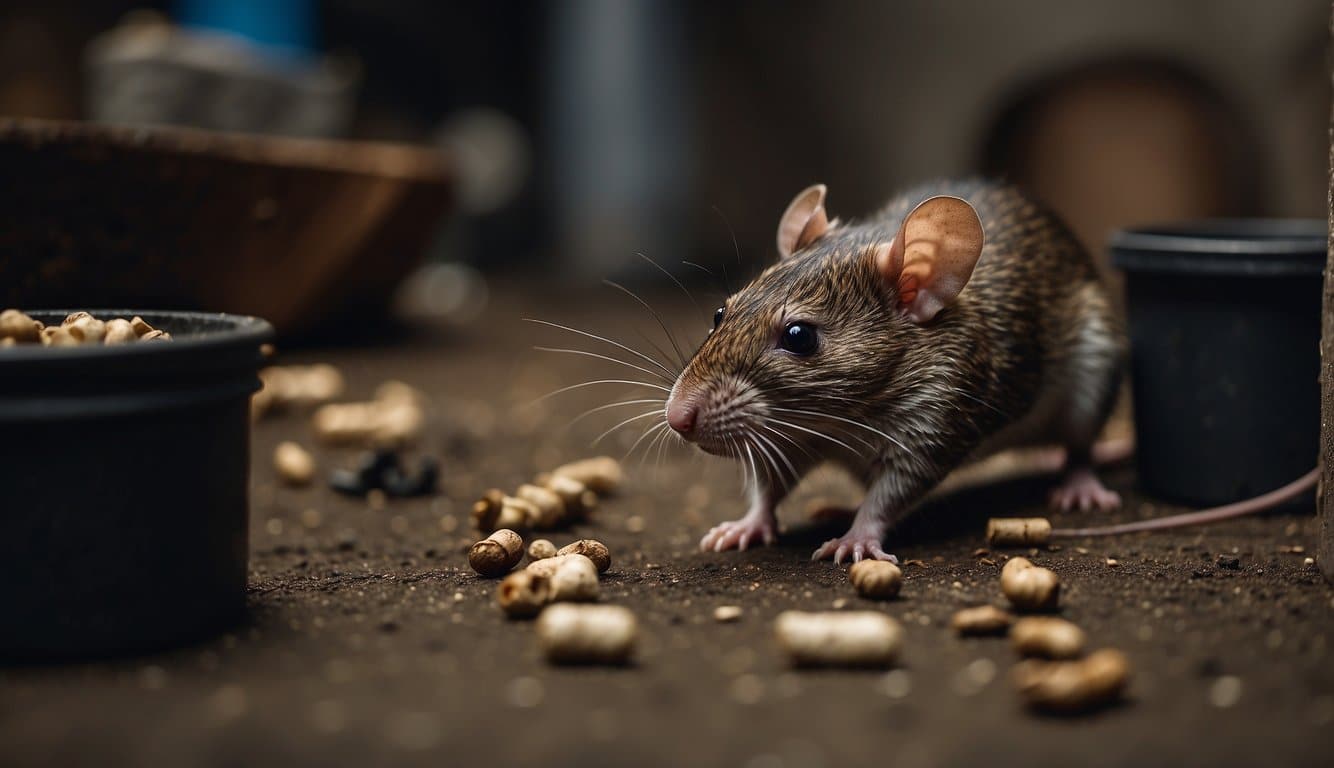Are there Rats
Before setting out traps and calling pest control, be sure you’re actually dealing with rats. Here’s the scoop on the tell-tale signs.
Signs of Infestation
- Droppings: One of the most obvious indicators that you’ve got rats is their droppings. They’re usually dark, banana-shaped, and about 1/2 inch in size. If you’re finding these little gifts around your place, it’s time to take action.
- Gnaw Marks: Rats love to chew! Keep an eye out for bite marks on food packaging, furniture, and even wires. Bigger gnaw marks usually mean a larger rodent, so watch out!
- Tracks and Runways: A little detective work can go a long way. Rats often leave dirt or grease marks along walls and floorboards. Check for little footprints or tail trails in dusty spots or mud.
Rat Species Recognition
- Norway Rat:
- Appearance: Brownish with scattered black hairs, a blunt nose, and a hefty body.
- Preferred Hangouts: You’ll find them on the ground floors, basements, or burrowing under buildings.
- Roof Rat:
- Appearance: Sleek, black or dark brown, with a pointed nose and a more slender body.
- Preferred Hangouts: These acrobats prefer the upper parts of buildings, trees, or ceilings.
Prevention Tactics
Before you start laying out traps, let’s make your home a fortress.
Key to this strategy is sealing up any potential rat doorways and tweaking your surroundings to say “no vacancy” to these unwanted guests.
Sealing Entry Points
- Inspect Your Home: Begin a thorough inspection around your house. Identify any holes or cracks that could be an entry point for rats, which can squeeze through spaces as small as a quarter.
- Materials Matter: Use sturdy materials like metal sheets, wire mesh, or concrete to seal off any entry points. Rats have strong teeth, so weak materials like plastic or wood can be gnawed through.
Environmental Modifications
- Tidy Up: Keep your outdoor area clean and free from debris. Woodpiles and heaps of junk are like luxury apartments for rats.
- Landscaping: Trim back trees and shrubs that are close to your house. Overgrown branches can serve as bridges for rats to enter your dwelling.
- Secure Food Sources: Secure trash cans with tight-fitting lids and avoid leaving pet food outside. A rat buffet is the last thing you want in your backyard.
Removal Techniques
When rats start crashing your pad, it’s time to take action.
Here’s how you can show those whiskered gatecrashers the door for good.
Baiting and Trapping
- Snap Traps: Your go-to for a classic takedown. Bait these with tempting treats like peanut butter and place them in areas where you’ve seen signs of rat activity. Remember, you’ll need to check these traps regularly and use caution when setting them up due to their powerful mechanism.
- Electronic Traps: For a high-tech zapping option, try electronic traps that offer a swift and humane finish. They’re perfect for indoor use and can be simply baited and set along the paths where rats frequent.
Natural Predators
- Cats and Dogs: Some breeds have a higher prey drive and may naturally keep the rat population in check.
- Birds of Prey: Inviting owls and hawks into your area by setting up nesting boxes can help reduce your rat problem. These feathered friends are natural hunters and can provide a long-term solution to pest control.
Chemical Solutions
When dealing with a rat infestation, chemical solutions can offer an effective route to rodent-free living.
You’ll find that tackling the problem head-on with rodenticides can be quite effective while ultrasonic repellers provide a tech-savvy approach.
Rodenticides
Here’s what you need to know about rodenticides:
- Types: There are various types of rodenticides available. Some cause dehydration, while others inhibit blood clotting, leading to internal bleeding. A popular choice is the anticoagulant rodenticide, which requires multiple feedings to be effective.
- Safety: Always prioritize safety. Use bait stations to prevent accidental ingestion by pets or children. Always read the label and follow the manufacturer’s instructions.
Ultrasonic Repellers
Add a tech edge to your pest control with ultrasonic repellers:
- Function: These devices emit high-frequency sound waves that are designed to be repulsive to rodents without affecting humans or domestic pets.
- Considerations: Though marketed widely, the effectiveness of ultrasonic repellents may vary. They might work best in combination with other methods rather than as a standalone solution.
Professional Help
When your home turns into a playground for pesky rats, tackling the issue effectively often requires professional intervention.
Below, explore how to bring in the big guns with pest control services and keep it all within the bounds of the law.
Hiring a Pest Control Service
- Find the Right Fit: Look for a trusted pest control professional that specializes in rat removal. It’s like finding a great camping spot – it needs to be perfect.
Questions to Ask Why It Matters Are you licensed? Ensures they meet state requirements Do you have experience with rat infestations? Expertise matters when you’re up against wily rodents What methods do you use? Knowing whether they use humane removal methods or not can be a dealbreaker to some. - Cost Considerations: Prices can range from affordable to a significant investment, so it’s wise to get multiple quotes to weigh your options. It’s like shopping for the best fishing gear; you want value and effectiveness.
Legal Considerations
- Stay Informed: Your local laws might have a say in how you can go about rat removal. Think of these regulations like fishing laws – they’re there for good reason, and it’s important to follow them.
- Wildlife Protection: Some areas protect animals, even pests, so confirm that your chosen professional follows all the necessary guidelines.
- Chemical Use: Just like certain baits are off-limits in streams, specific poisons for rat control might be too. Make sure the methods used are legal in your area.
Frequently Asked Questions
Rats can cause quite the headache, but don’t worry; you’ve got several strategies at your disposal to tackle these pesky intruders.
Let’s explore the most common questions you have about getting rid of them.
What are effective methods to eliminate rats in my garden?
- Set out snap traps around your garden, particularly near locations where you’ve observed rat activity.
- Consider adopting a cat or dog; their presence can deter rats from taking up residence in your outdoor space.
What’s the quickest way to rid a house of rats?
- Deploying a variety of traps, such as electronic traps, can quickly reduce a rat population.
- Contact professional pest control services for fast and decisive action against a rat infestation.
What are humane ways to deter rats from my home?
- Seal entry points to prevent rats from accessing your home, focusing on gaps as small as a dime.
- Ultrasound devices can repel rats without causing them harm by emitting sounds unpleasant for rodents.
How can I permanently keep rats away from my property?
- Eliminate food sources by securing trash bins and removing pet food from outdoor areas.
- Integrate natural predators into your environment by installing owl boxes to attract these natural rat adversaries.
What scents or substances can prevent rats from entering my space?
- Rats dislike the scent of peppermint oil; use a diluted solution to spray around potential entry points.
- Ammonia has a strong odor that can act as a rat repellent; however, use it cautiously due to its potential health risks.
What are the best strategies for dealing with rats in hard-to-reach places like walls or ceilings?
- Set traps in your attic or crawl spaces where you suspect rat activity.
- For a long-term solution, ensure proper sealing of all cracks and consider installing barriers to prevent re-entry.
Last update on 2025-04-20 / Affiliate links / Images from Amazon Product Advertising API




